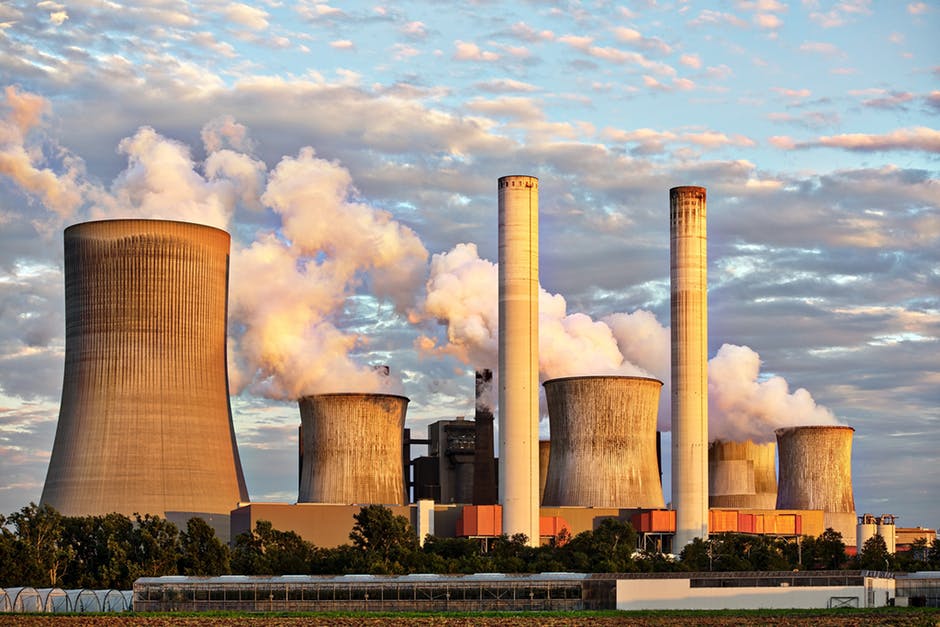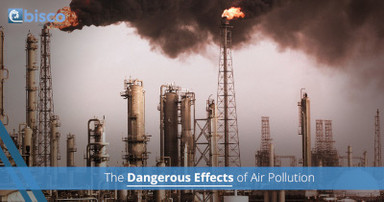Dec 15th 2017
The Dangerous Effects of Air Pollution
Despite the introduction of the Clean Air Act in 1970, air pollution in the United States continues to harm people’s health and the environment. From metalworking facilities to welding processes, unchecked air pollution can be a dangerous health risk to employees, so it’s critical for companies to invest in air cleaning applications such as dust collectors and mist collectors. At Bisco Enterprise, we understand how important air quality control is in industrial facilities, which is why we offer the best air cleaning systems available on the market today. In this article, we’ll discuss the dangerous effects of air pollution and how you can help to reduce them in and around your manufacturing facility.

Toxic Particles
If you or a loved one work in a manufacturing facility, there’s a good chance you’re required to wear protective masks to avoid the inhalation of hazardous particles. Exposure to inhalable toxic particles can have a negative effect on your lungs and heart. Small particles that are less than 10 micrometers in diameter can travel deep into your lungs and potentially enter your bloodstream. Workers who suffer from heart or lung diseases such as congestive heart failure or asthma are more at risk for these health issues.
If you’re looking for ways to reduce the amount of particulate matter exposure in your facility, contact the experts at Bisco Enterprise today. We offer a large selection of air cleaning products for a variety of industries including composite, welding and metalworking manufacturers and we can help you choose the best air cleaning solutions for your facility or warehouse.
Acid Rain
Acid rain, also known as acid deposition, is a broad term that includes any form of precipitation with acidic components. Acid rain is formed when sulfur dioxide and nitrogen oxides are emitted into the atmosphere and carried by air currents or winds. These two elements can react with water, oxygen and other chemicals to form both sulfuric and nitric acids. This can cause rain, snow, hail, or even dust that is harmful and acidic. The major sources of sulfur dioxide and nitrogen oxides in the atmosphere are often caused by:
- The burning of fossil fuels needed to generate electricity. Approximately two thirds of the sulfur dioxide and one fourth of the nitrogen oxide in the atmosphere comes from electric power generators.
- Motor vehicles and heavy manufacturing equipment.
- Other manufacturing industries and oil refineries.
The Two Forms of Acid Deposition
There are two main forms of acid deposition to be aware of: wet and dry deposition. Wet deposition is what we commonly think of as acid rain. This is when sulfuric and nitric acids are formed in the atmosphere and fall to the ground in the form of rain, snow, hail, or fog. Dry deposition, on the other hand, are acidic particles and gases in the atmosphere. These acidic elements may deposit to surfaces quickly or may react dangerously to an atmospheric transport.
The Dangers of Acid Rain
Acid rain has a tremendously negative effect on our ecosystem and the environment. The ecological effects of acid rain can most clearly be seen in aquatic environments, such as streams, lakes and marshes. Not only can acid deposition harm plants and wildlife, it can have negative effects on human health as well. When the harmful pollutants associated with acid rain are in the air, employees run the risk of inhaling them into their lungs. Many scientific studies have found that there is a clear correlation between these particles and negative effects on the heart and lung functions.
Climate Change
Climate change refers to any significant change in climate that lasts for an extended period of time. Over the past century, human activities have led to the release of large amounts of carbon dioxide and other greenhouse gases into the atmosphere. The majority of these hazardous gases come from burning fossil fuels for energy, industrial processes and some agricultural processes. In 2009, the Environmental Protection Agency (EPA) determined that the emissions of carbon dioxide and other greenhouse gases built up in the atmosphere can endanger the welfare of current and future generations by causing climate change and ocean acidification. Greenhouse gases, which trap heat in the atmosphere, include carbon dioxide, methane, nitrous oxide and fluorinated gases. Scientists have warned that carbon pollution and climate change are expected to bring more hurricanes, storms, frequent flooding and severe wildfires.
At Bisco Enterprise, we’re proud to be a leading provider of air pollution control solutions for a variety of industrial manufacturing and automotive industries. We specialize in supplying quality portable dust collectors and portable fume arms to improve the air quality inside of your facility. If you’re interested in learning more about our premium air cleaners and dust collectors, contact our experts today!
Ozone Layer Depletion
The ozone layer in the stratosphere protects life on earth by filtering out harmful ultraviolet radiation (UV) from the sun. When ozone-degrading chemicals such as chlorofluorocarbons are emitted into the atmosphere, they eventually rise to the stratosphere. Upon their stratospheric arrival, the chlorine and bromine in these chemicals can initiate a dangerous chemical reaction that can destroy the ozone. Due to higher levels of ultraviolet radiation, these chemicals can lead to a variety of health and environment effects such as:
- The reduction of crop yields
- The possible decline of amphibian populations
- Skin cancer
- Cataracts
- Impaired immune systems
In the United States, ozone-depleting substances are regulated as class I or class II controlled substances. Class I substances typically have higher ozone depletion potential and most have been completely phased out in the U.S. with a few exceptions. Class II controlled substances are all hydrochlorofluorocarbons (HCFCs).
Ways To Reduce Air Pollution In Your Facility
If you’re looking for ways to reduce the air pollution in your metalworking or composite warehouse, the experts at Bisco Enterprise have compiled a thorough list of tips below.
Tip #1: Invest In A Dust Collector
A dust collector is an innovative system used to enhance the quality of air released from industrial and commercial processes by collecting dust and other airborne impurities from air or gas. Specifically designed to handle high volumes of dust, these air cleaners are used in a variety of manufacturing and industrial processes. At Bisco Enterprise, we offer a large selection of dust collectors to improve the air quality inside of your facility. If you’re interested in learning more about our air cleaning solutions, contact us today!
Tip #2: Get A Mist Collector
Mist collectors are unique machines used to minimize the adverse effects of exposure to metalworking fluids to help facilities comply with indoor air quality standards. They can also improve in-process part quality by keeping work surfaces clean of dangerous airborne particles. With the large variety of mist collectors available on the market today, it can be difficult trying to decide on the best model for your facility. If you need assistance choosing a mist collection system for your industrial application, contact the professionals at Bisco Enterprise today!
Tip #3: Install A Fume Collector
Many welding, soldering and marking operations result in the production of hazardous fumes or smoke that can be dangerous to both people and the environment. Fume collectors capture harmful fumes and particulate at the source, eliminating them from the air to provide a safe environment for employees.
If you need assistance choosing the best air pollution control solutions for your warehouse or manufacturing facility, contact Bisco Enterprise today!

